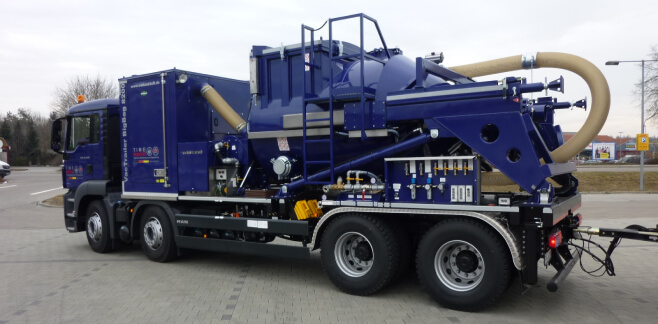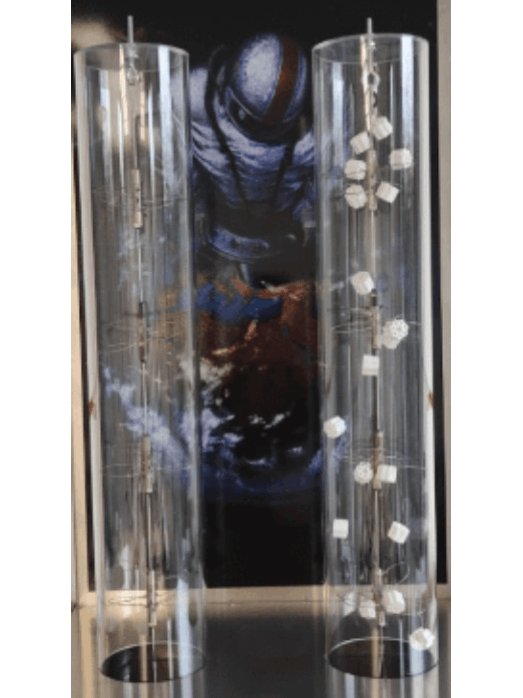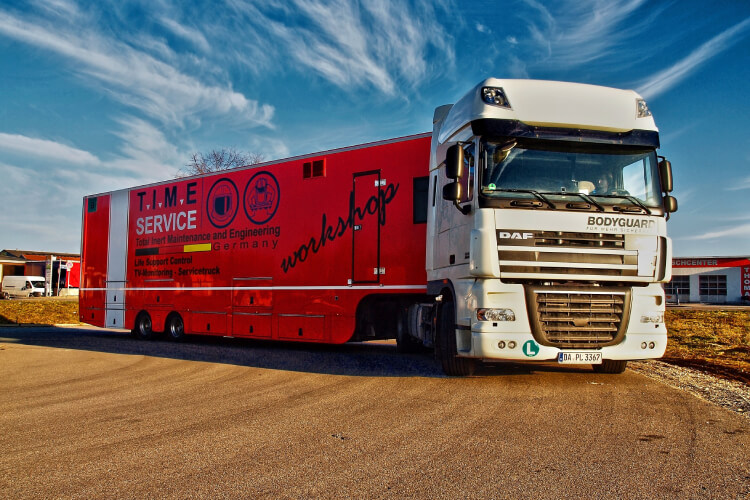The name T.I.M.E. Service stands for own developments, CE certificates and patents. What we do not build ourselves in our own technical centre, we build with selected technology partners so that our expertise and many years of know-how can flow into the implementation of innovative technical developments.

T.I.M.E. Life Support System
T.I.M.E. Service has designed, built and CE certified its own breathing apparatus – the Life Support System – for safe working in inert atmospheres. The LSS is a overpressure system equipped with an integral respiratory protection helmet, redundant air supplies and a duplex communication system. The primarily mechanical system offers the highest level of operational reliability and is not affected by power failures. The fully digital monitoring system for supply pressure, respiratory physiology and reactor atmosphere, including data storage, offers the user maximum safety.

The central part of the Life Support System is the respiratory protection helmet with two integrated independent air supply systems, 2 exhalation valves and an emergency air cylinder connection as a third air supply. Our third generation helmet has an unrivalled low weight with high wearing comfort thanks to the helmet shell made of carbon.
The complete Life Support System is manufactured in our workshop in Germany and certified according to CE 0158.
Our specialists are specifically trained for the use of the Life Support System under inert conditions and always undergo occupational medical examinations. All functions are continuously checked by an experienced LSS team leader on the monitoring module during the operation. For safety reasons, the helmet wearers are monitored by camera. Our life support systems are equipped with a multi-channel system with cameras in the control room, at the top of the reactor and inside the reactor. In addition, a high-resolution inspection camera is used if required. The data is recorded and transferred to a PC.
Unloading systems

Vacuuming units
T.I.M.E Service has more than 14 different mobile vacuuming units with integrated nitrogen recirculation, which are particularly suitable for the vacuuming of pyrophoric and fragile bulk materials, such as catalysts, activated carbon, molecular sieve, etc. This avoids as far as possible the breaking of valuable catalyst material that is subsequently to be regenerated. T.I.M.E. Service has developed vacuum systems for self-igniting catalysts in cooperation with specialised manufacturers. All units are specially designed to handle the catalyst material gently. Our units operate in a closed-loop system. The catalyst material is continuously and dust-free filled into the required containers.

Soft-Flow-Hopper
T.I.M.E Service uses Soft-Flow Hoppers which, in conjunction with suitable hose lines, ensure gentle and non-destructive discharge of catalysts and bulk materials of all kinds from greater heights.
The -Soft-Flow-Hopper is a separation system for fragile bulk materials/catalysts. The Soft-Flow funnel is generally used to reduce abrasion in the suction area of reactors over 15 meters high to reduce abrasion during vacuuming. The system is installed at the head of the reactor to reduce the suction distance by at least 50%. The extracted material is then fed downwards via a dump pipe into desired containers.

Dust control “black-grey cabin”
During unloading, it is essential to prevent material and dust emissions into the environment.
For this purpose, T.I.M.E: Service has developed and built a special “black-grey cabin” in which the catalyst material is safely and emission-free discharged into the collection container. The operator is safely protected by our respiratory protection system and at the same time any dust generated is extracted at several points in the container.

ATD-Cardox
T.I.M.E. Service has a number of ATD-Cardox kits which can be used to dissolve blocked catalyst material in a reactor.
The ATD-Cardox system consists of a reusable metal tube, inside which is a charge of liquid carbon dioxide and a chemical energiser. When the carbon dioxide inside the tube is triggered by a small electrical charge, it rapidly expands and breaks up the material. The process takes less than a second and without the risk of igniting flammable materials or gases nearby.
With ATD-Cardox, misfiring can be largely eliminated.

Air lancing systems for tubular reactors
T.I.M.E. Service uses air lancing systems on tubular reactors with an internal diameter of 25-50 mm at a length of up to 15 m. From the tube level, a vacuum attachment and an 8-15mm diameter high pressure spiral with a specially designed nozzle are introduced into the catalyst tubes. The high-pressure spiral transports air or nitrogen into the tube and the loose material is brought out together with the air or nitrogen.
The great advantage of air lancing is that there is no dust or build-up on the inside of the tubes after emptying and that and the entire working area above the tube sheet is dust-free. Air Lancing is fast and can also be used to gently remove deposits using special nozzles. This method does not require opening the lower springs or caps. The reactor can be reloaded directly after a camera inspection or empty tube check.

Fish taping – Piercing wire for tubular reactors
Fish taping is an alternative for emptying long tubes with a smaller diameter (<25 mm). Tube bundles with stainless steel springs at the bottom are often opened from below to dump the catalyst material. This is where we use fish taping. Without damaging the inside of the tube, our specialists carefully loosen the material with a piercing wire.

Drilling equipment for tubular reactors
Depending on the process, blocked catalyst material may occur in tubular reactors and cannot be removed by simple vacuuming. At T.I.M.E. Service we use mechanical drilling equipment to carefully drill out the blocked areas. The flexible use of extensions allows it to be used in any tube length. The drilling attachments on the head of the drilling equipment are selected and used as needed to avoid damage to the tubes.

Brushing machines for tubular reactors
Efficient brushing machines are used to gently clean tubes and remove coke-containing deposits. Internal tube cleaning is carried out using flexible shafts and brushes of various sizes and materials, e.g. various cleaning brushes, wire cables with cobalt tips, centrifugally activated serrated cones and scrapers. The brushing machine is either pneumatically or electrically driven.
Loading systems

PRO DENSE technology for fixed-bed reactors
Our licensed Dense Loading Technology PRO DENSE is recognized by well-known catalyst manufacturers and international customers:
-
Loading capacity of up to 15 tonnes per hour
-
Catalyst breakage minimised when loading using external motor
-
Dense loading possible up to 300mm below floor level
-
Precise and stepless adjustment of speed and direction
-
Quick and effective adjustment of the flow and profile
-
Even and wide distribution of the catalyst with minimal dust formation

Soft loading pipes for ceramic material
Soft loading pipes are used for gentle loading of ceramic material into fixed bed reactors. Offset flat plastic parts slow the free fall in the filling line.

Dedusting modules for fresh material
The use of a dedusting module is essential to achieve gentle and uniform catalyst loading with an optimum pressure difference in tubular reactors. Immediately prior to loading, the fresh material passes through 2 long mesh screens. A multi-stage suction nozzle removes dust from the material in three stages, and a valve at the outlet of the module regulates the flow rate. This is necessary because the transport of fresh material creates abrasion that must not enter the tubes.

Loading machines for tubular reactors
Conveyor belt machines or vibration machines are used in the loading of various tubular reactors. The selection is based on catalyst quality and requirements:
-
Loading procedure for all variants of tubular reactors
-
Loading of 8-10 tubes in tubular reactors
-
Uniform loading
-
Flexible application for different tube pitches
-
Simple structure
-
Easy to move
-
Easy to operate

Insert loading system for EO plants
Insert loading systems are suitable for fast and efficient loading of e.g. ethylene oxide (EO) plants which are loaded with only one catalyst layer. For each EO plant, the appropriate inserts are calculated and manufactured according to requirements, reactor and catalyst dimensions. We use the so-called hourglass effect. The aim is to achieve the same loading speed in each tube, the same loading quantity and the same prescribed free height in each tube.
-
Uniform loading due to individual design and active dust extraction
-
Uniform charging speeds
-
Achieving the prescribed free height through inserts whose length was determined in calculations and test trials
-
No vacuuming necessary after loading
-
2 to 3% more catalyst in the tubes
-
Use of high quality processed materials
-
Loading from BigBags is possible

Pressure drop measuring systems
T.I.M.E. Service uses specially developed deltaP measuring devices. We have single and multi-channel systems with up to six parallel channels. With our equipment we can efficiently and reliably carry out pressure drop measurements on all types of tubular reactors and reformer furnaces after catalytic loading.
The software on our deltaP units allows a tube sheet overview to be displayed with the measured values, unmeasured tubes are easily identified and thermocouples are taken into account. Data is stored and transmitted to the customer.

CATNET® for cracking furnaces and reformer tubes
CATNET® is an efficient, modern technology for time-saving, easy catalyst loading of reformer tubes with inside diameters from 70 to 300 mm.
CATNET® procedure: Simple and efficient handling
STEP 1: Unloading by vacuuming
STEP 2: Video inspection of the emptied reformer tubes
STEP 3: deltaP measurement of the emptied tubes
STEP 4: Loading by CATNET procedure
STEP 5: Final deltaP measurement
CATNET® overview
– Short loading time
– No pre-dosing required
– No vibration of the tubes
– Uniform result of the deltaP measurement
– Less catalyst wastage due to spillage
– No bridging
– High, uniform density
Accessories

Workshop trailer
T.I.M.E. Service has built and equipped a workshop container that is used as a backup on large construction sites. Respiratory protection helmets can be cleaned and maintained after use, and any technical failures can be addressed flexibly with spare parts and short-term repairs. This means we have no downtime in the event of a malfunction and save costs through fast response times.

